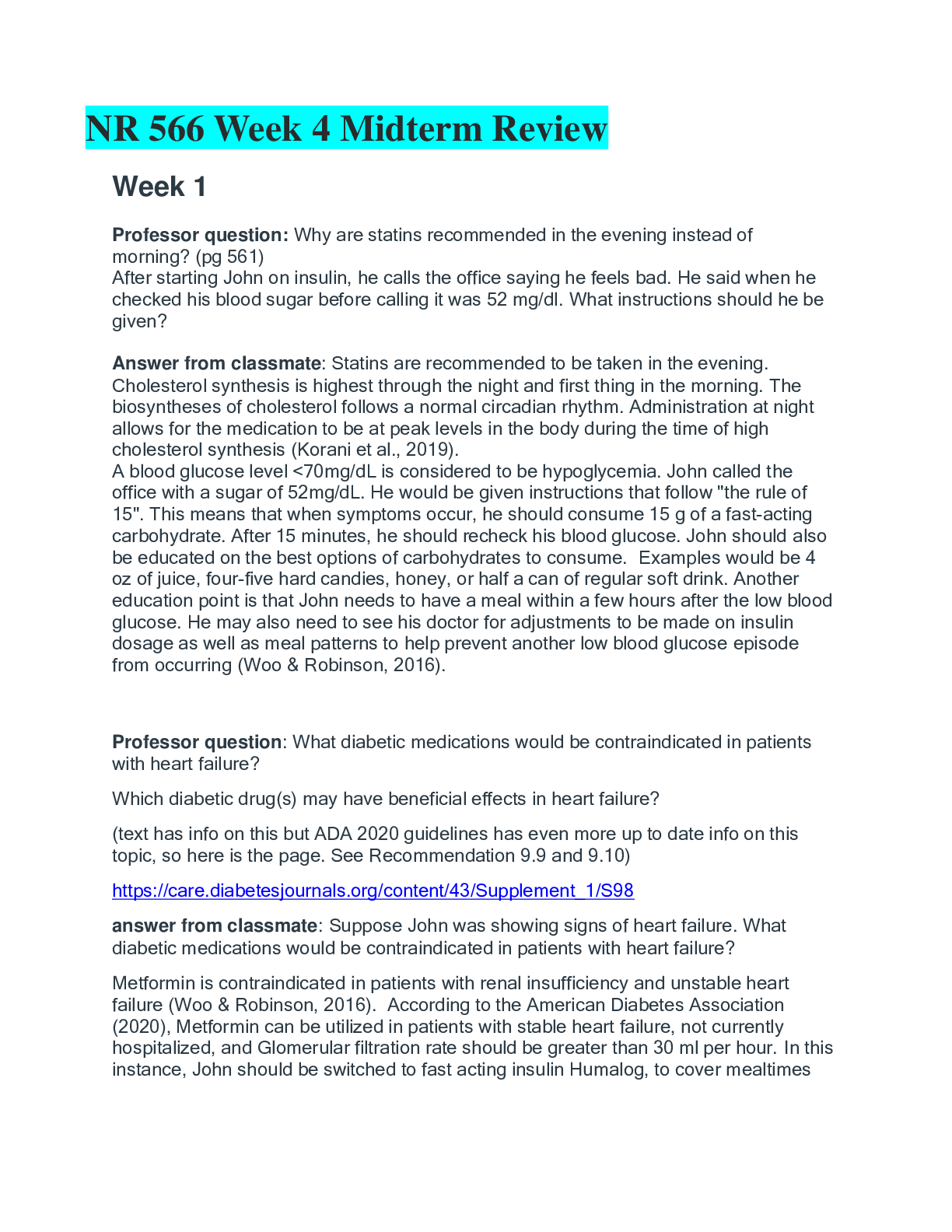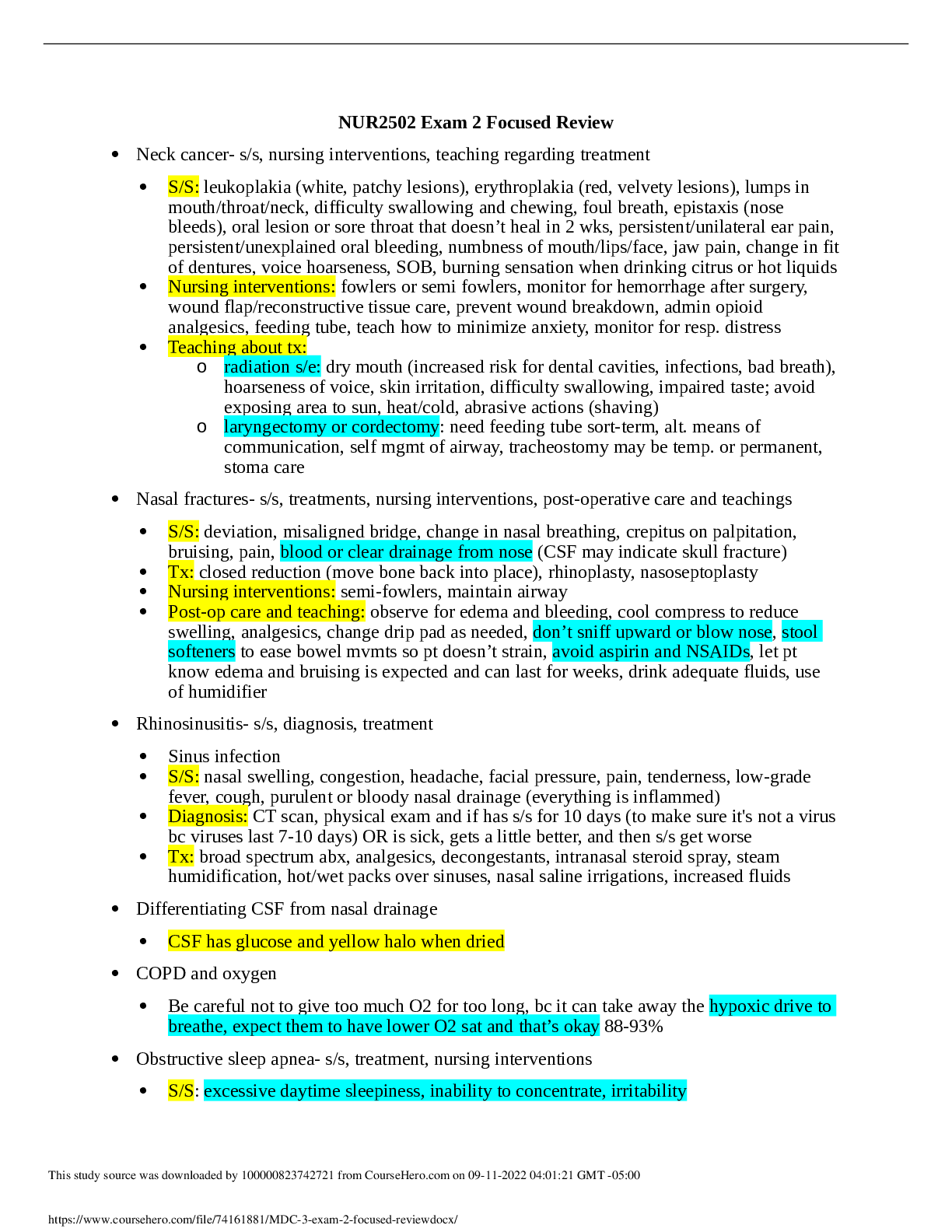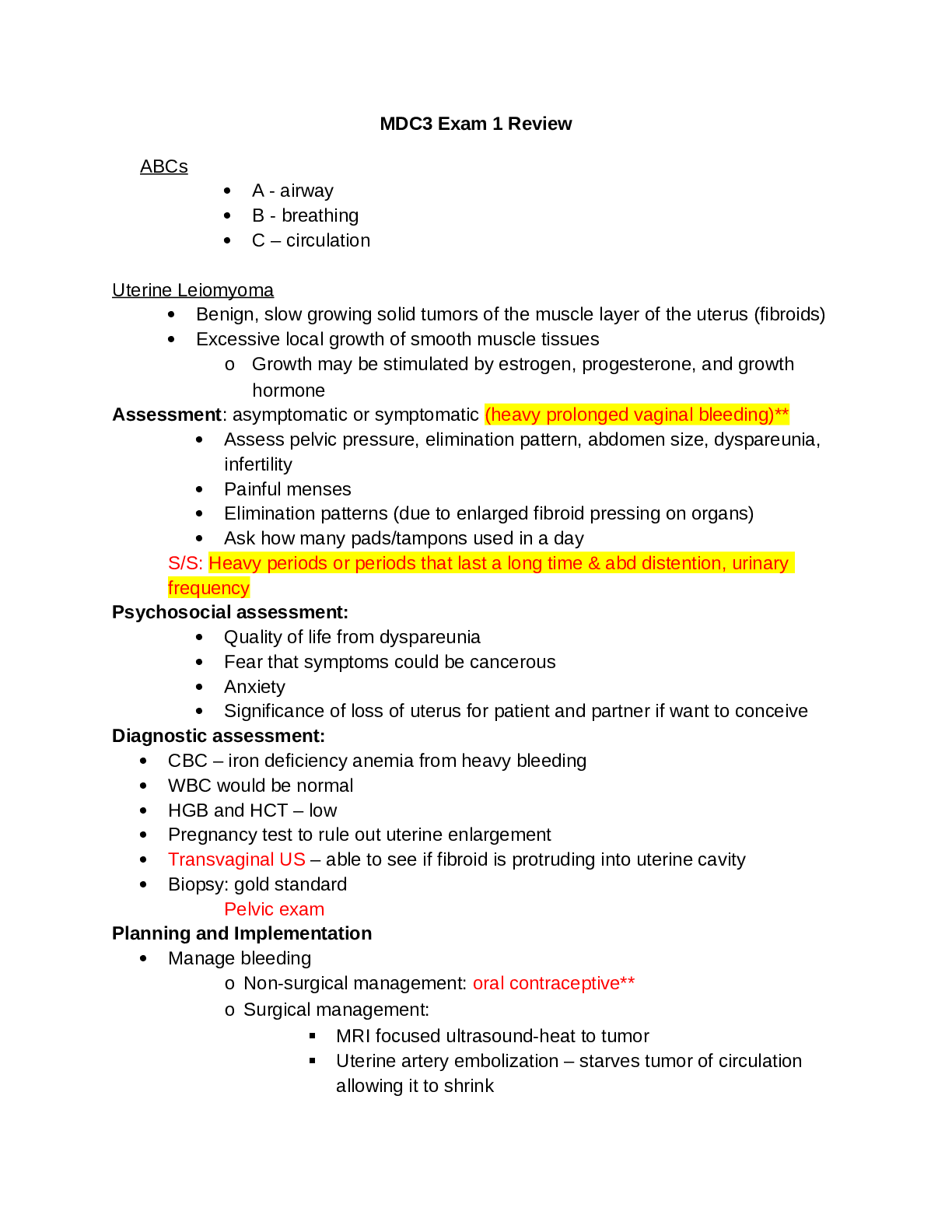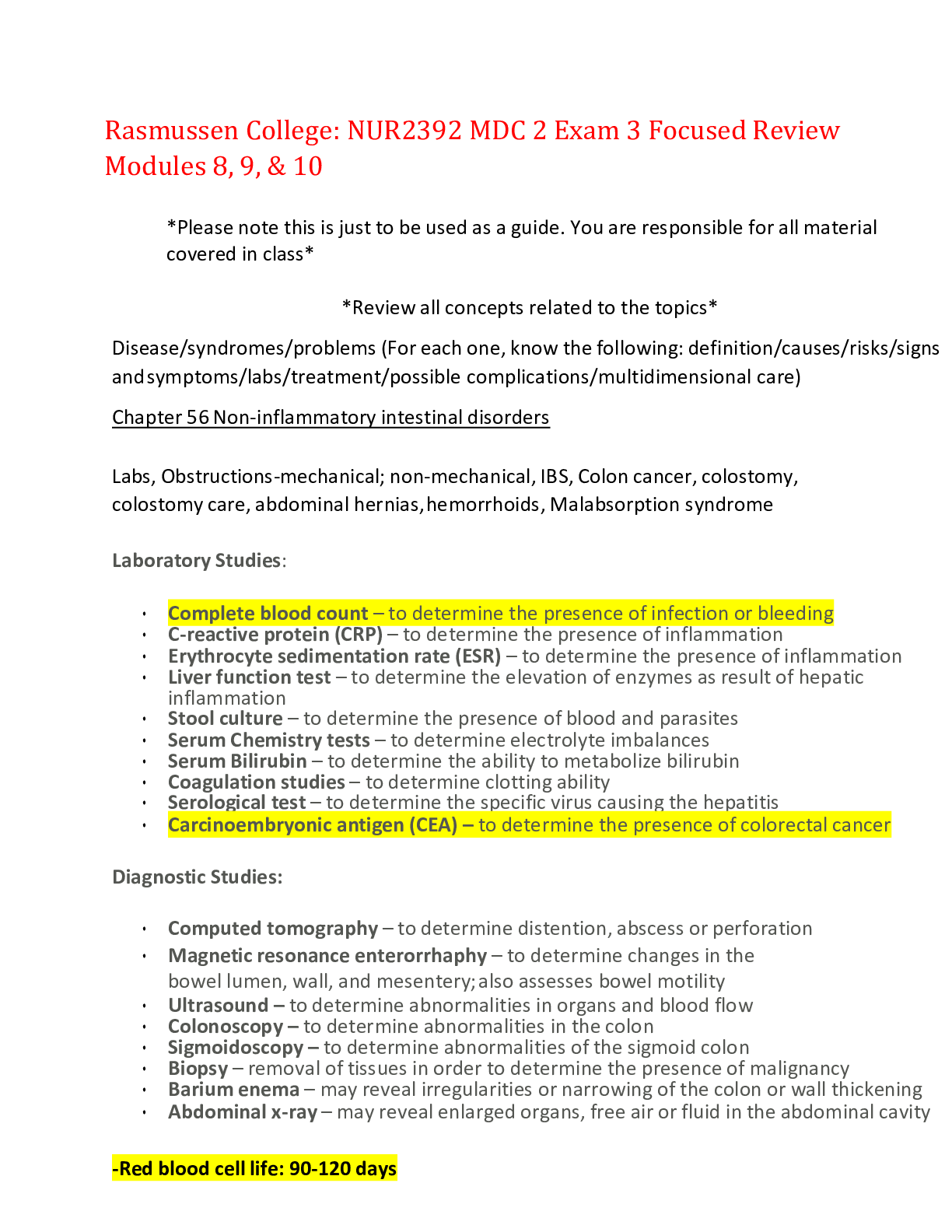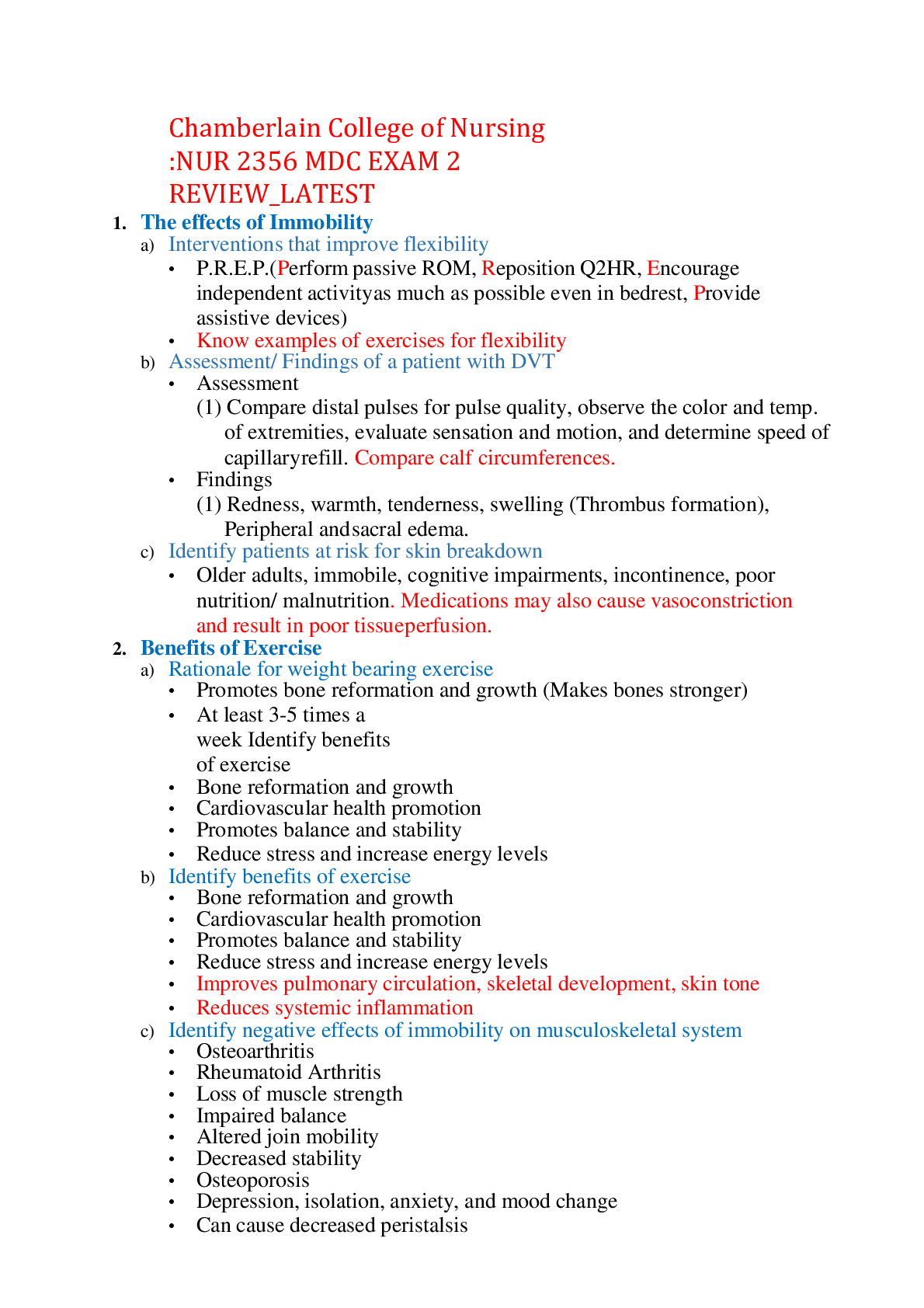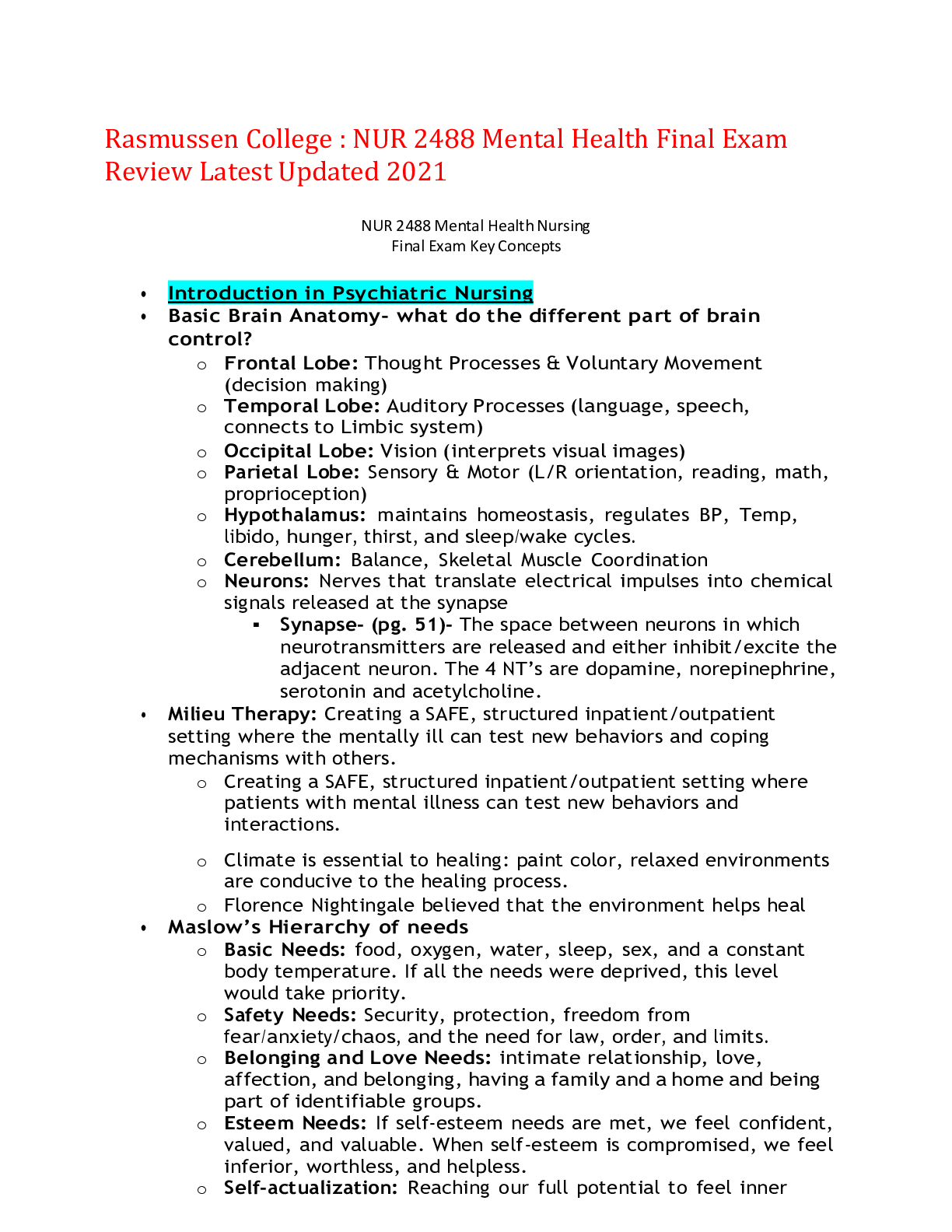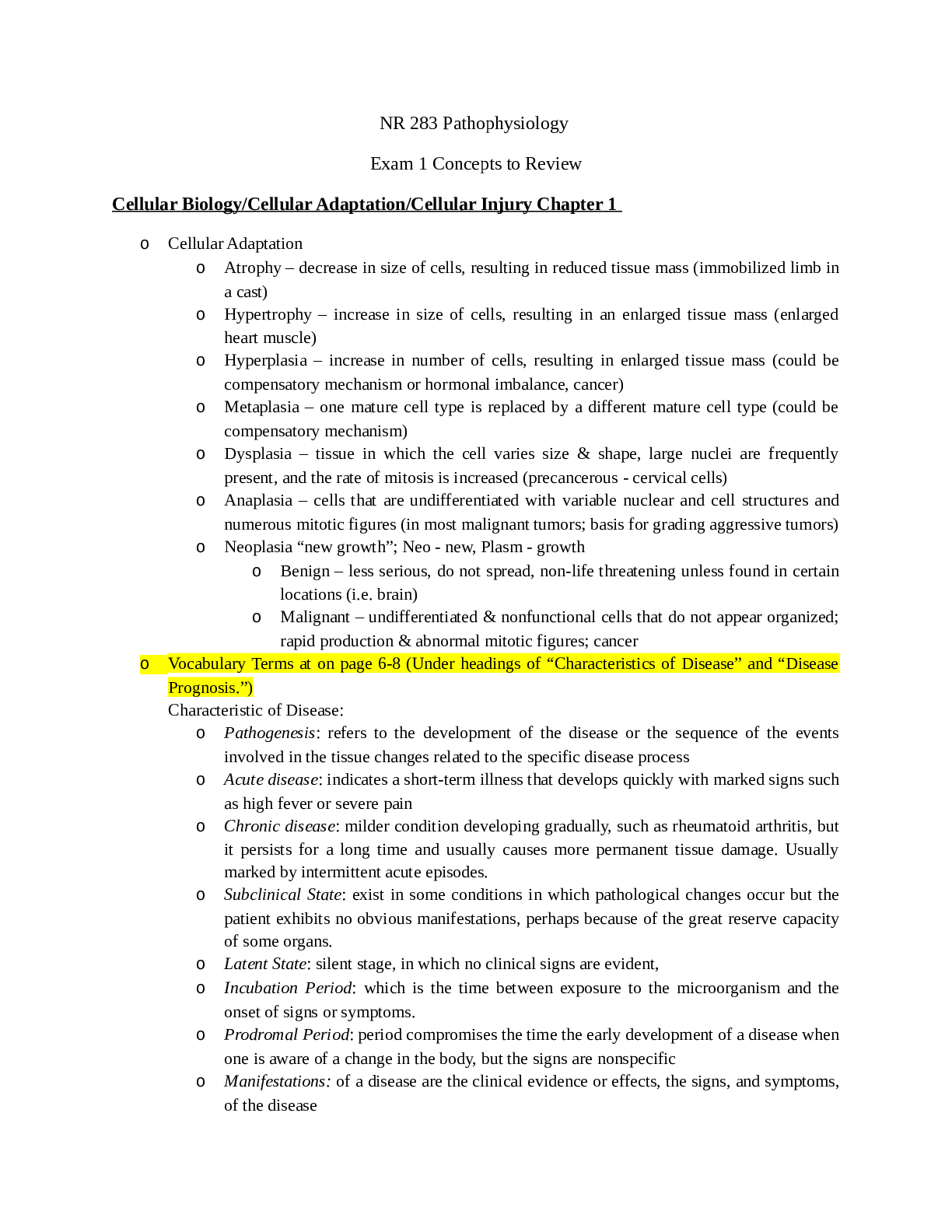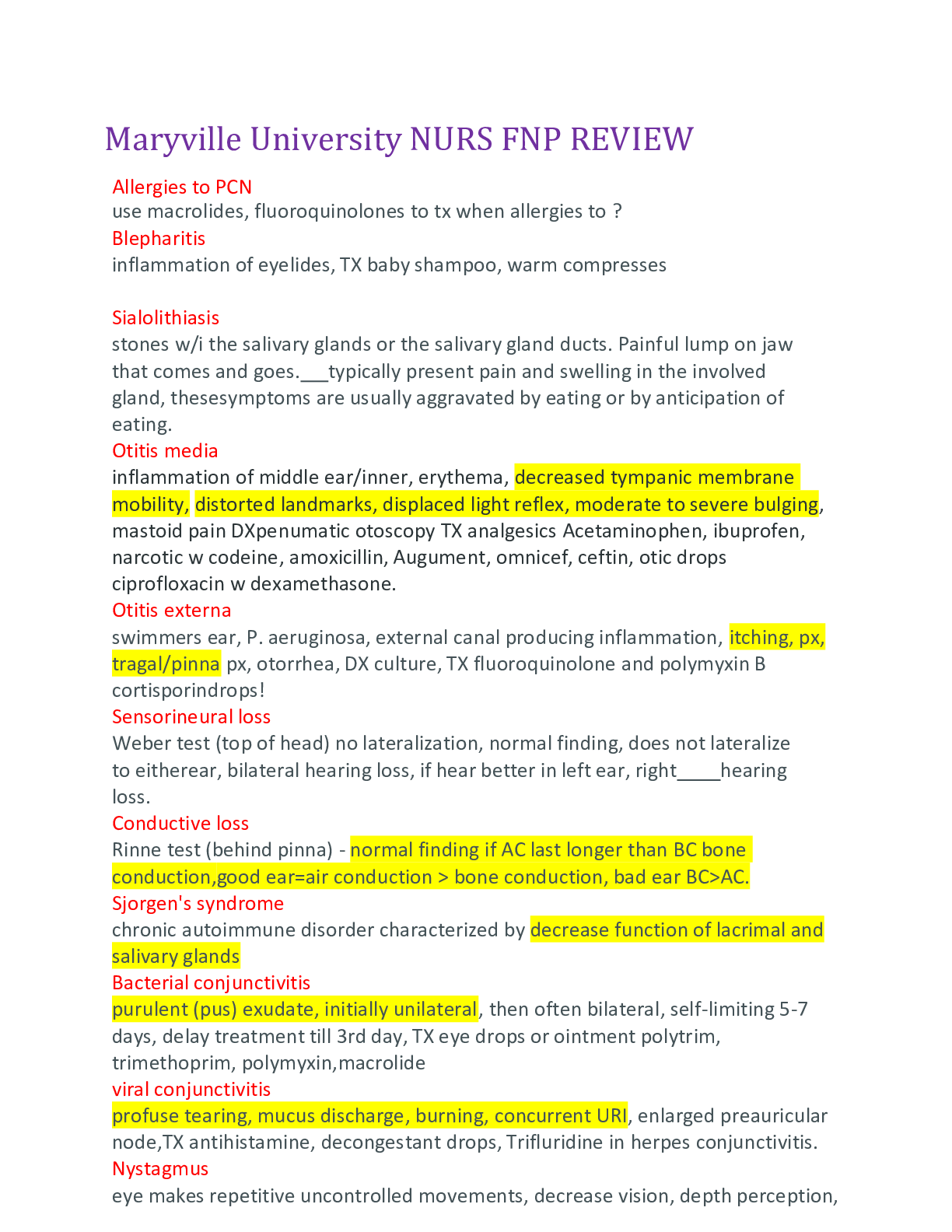*NURSING > EXAM REVIEW > Maternity and Peds Hesi Review 2,100% CORRECT (All)
Maternity and Peds Hesi Review 2,100% CORRECT
Document Content and Description Below
Maternity and Peds Hesi Review 2 Hesi 2015 1. woman had variable deceleration. What is nursing action? Turn her on her side 2. parents asking nurse why heel stick is important for baby? It is routi... ne exam to check for metabolic deficiency 3. patient was on drug; what is side effect? Rapid abdominal girth 4. drug calc: magnesium sulfate, convert from mL to units. 240 mg 5. herpes 2 baby: put baby in isolation room 6. Coke baby: mother was diagnosed with Coke. Baby is irritable, cries a lot. 3.2What do you do? Initiate seizure precaution 7. Woman on Pitocin suddenly has problems&has variable decelerations. What do you do? Turn off Pitocin decrease Pitocin 8. Mom wants to know what substance to use when changing baby’sdiaper: Clean water baby lotion, talcum powder 9. Woman’s hematocrit (values)&hemoglobin (value) levels are abnormal but she says she’s been eating green veggies. She wants to know how pregnancy effects these lab values.nurse says: plasma volume affects 10. Mom has mastitis. She is on antibiotics. Nurse advises patient to: Initially breastfeed onunaffected breast 11. New mother states her nipples are tender after breastfeeding for 2 days: assess position of infant while breastfeeding 12. Mom unsure about being a good parent: determine support from family, friends 13. Mother is breastfeeding&wants to know what contraceptive to use: condoms&diaphragm with spermicide 14. Mother has diaphragm after birth & wants to know if she should get new one? Use alternative contraceptives until she gets new one 15. Nurse discovers postpartum Pt has a boggy uterus&is on left side. Encourage patient to void 16. Mother is given Atropine. What to look out for? Increased pulse&dry oral membranes/secretions 17. Mother has DM type 1, what do you expect for fetal complications? Hypoglycemia 18. forgot question but answer is: start IV of lactated ringers at 200mL/hr 19. Pt has history of “heart damage”. She haspotential to have heart failure. What is her nursing Dx? fluid volume excess. MP Hesi 2016 Highlighted = on my HESI 2016 version (it depends on which version you may have which questions you will see below) • Good source of folic acid – peanuts • Mom getting hypotensive on spine board after car wreck – roll her on her side on spine board • Mom goes to bathroom with contractions 5 min apart, you hear baby cry – hit call light for help • Iron (SATA) – dark stool normal, give at bedtime • Man calls clinic says his wife has been sad, happy, moody – tell him normal hormonal changes • Mag question – stop infusion due to mag tox • Contractions get really close&she is dilated, stop Pitocin, then contractions get 5 min apart – restart Pitocin per agency policy • Bright red trickling blood – lacerated cervix • Teach adolescent pregnant girls – proper nutritional needs • 42 wkballard score – check blood sugar • Breast feeding woman asks about birth control – breast feed only every 2-3 hrs • Rubella vaccine – use birth control for 28 days • Baby as white curd patches in his mouth – discuss medicine with mother (candidiasis infection) • Mom has baby – she reaches out&traces profile with fingertips • HIV positive mom gives birth&is worried about passing it to baby – explain to mom AZT for baby after birth • Baby has to have COOMBS test, mom doesn’t want rhogam but will keep her from building up antibodies for future babies • HSV 2, baby born, vaginal delivery – isolate in nursery • Hormone for positive pregnancy test – human chorionic gonadotropin (HCG) • Swollen vagina is normal in female infant • Moro reflex is normal in infant • 800 ml output in an hour with mag question – just continue whatever you are doing • Woman has baby in a cab – start pitocin, massage fundus • Woman comes in with pain in her stomach – you start an IV, not type&cross blood • Put eye ointment in conjunctival sac of newborn (erythromycin) as prophylactic eye ointment for prevention of eye infections contracted from bacteria in birth canal • Had kid now complains of vaginal pain fullness – check vaginal/perineal area • Swollen vagina question is long&talks about salt wasting – normal finding explain about androgens • -1 placement of baby active labor 3 cm dilated, has to go to bathroom – check Pt’s cervix • Baby born to diabetic mother – check baby’s blood sugar • PKU baby – 25% any babies will have it too • Baby with clavicle problem – will have intracurvature • Question about a woman who drinks&has cut down – give her an “atta boy”&encourage her to reduceamount even more • Woman getting radiation iodine – hold off on test to confirm if pregnant or not • Some type of fertility drugs – you need to report sudden increase in abdominal girth • Breast feeding baby&sore nipples – start feeding onunaffected breast • Breast feeding mother has a diaphragm – use condom&foam until diaphragm can be refitted • Baby born to mother who has a positive drug screen for something – monitor baby for seizures • Baby has an apgar score of 3 – continue resuscitation • Baby is jaundice&brought back to hospital after 7 to 10 days – provide eye protection&placed under light or phototherapy • Pregnant woman with low Hct Hgb levels – this is normal because of increase in plasma levels • Woman in labor lying in supine position states she is finally comfortable – place a wedge under her right hip • Preparing a woman for triple screen or something test – you need to prepare to draw blood lab work • Woman comes in stating her water broke – test with nitrate paper&if it turns blue then prepare to admit • Woman is having an amniocentesis test – nurse should check for signs of labor once it is complete • A newborn weighs 7.5 lbs at birth&weighs 7 lbs 24 hrs later – this is normal weight loss • Something about woman 12 weeks prenatal visit. What is important to discuss at this time? It is a cultural question answer is something about – birthing plans or techniques • Baby weighs over 9 lbs – assess for fracture of clavicle • Pt with non-reassuring pattern – stop Pitocin infusion • Baby 28 weeks – hemodilution – anemia (hemodilution of pregnancy peaks at 28 weeks results in decreased Hct) • Parents in transition stage – maintain relationship with extended family • Which block deadens vagina&perineum – pudendal block • Woman comes in vomiting with low BP – give antiemetic • There are two questions on apneic baby – rub baby’s trunk & flick soles of feet • Neonate is apneic for 20 seconds – rub baby’s trunk • Teaching pregnant teensabout – iron deficiency anemia • A woman is 5 hrs postpartum with fundus 3 cm aboveumbilicus&toleft – encourage her to void/urinate • Woman is certain number of weeks, which method is best to determine fetal position - ultrasound • Baby born to mother that tested positive for cocaine – nursing priority is seizure precautions • Neonate respiratory distress – nasal flaring • Mother has a firm fundus but continues to have bright red blood trickling from vagina, what is possible indication – lacerated cervix • During fundal massage, place one hand atfundus, what issecond hand used for – to anchor fundus • There is a question that has to be put in order – isolatebaby,move mom to private room, collect u/a, start iv • How do you measure frequency of contractions – frombeginning of one tobeginning ofnext • Mothers Hemoglobin A1C – give consultation to a nutritionist • Baby shows cyanosis in hands&feet&has elevated respirations – gradually warmbaby • Baby is showing signs of mottling – check temp • Mom is at 20 week gestation&has gained 20 lbs, what is of most concern out ofdata of mom – increased weight gain • Mom asks why her baby is being screened for T4&TSH levels – it is state protocol to monitor for metabolic abnormalities • Pt having labor back pain – counter pressure on lower back • Woman had cleft lip, uncle had cleft lip – send for genetic testing • Woman in labor&they look at vagina&see cord – put woman in Trendelenburg position • Pregnant woman has a diaphragm – she needs to have it refitted for another diaphragm • Baby starts showing signs of respiratory difficulty (nasal flaring, expiratory grunt, cyanosis) – check O2 saturation levels • Baby progressing in extrauterine life would show what signs – good vigorous cry with stimulation • Baby has peri-oral cyanosis – assessoral mucosa • Before surgery mom is given an anticholinergic/atropine with anesthesia. What istherapeutic response ofanticholinergic – increase pulse&decrease oral secretions • Question about cytotec – answer isincreased risk for abortion • Pts uterus is aboveumbilicus&toright during postpartum, what do you do 1st – palpate bladder for distention • Mom feelsurge to defecate during labor – do a vagina exam • What isreason to do an ultrasound on a mother at 20 weeks gestation – ultrasound for gestation&fetal growth • Pt is taking mag sulfate&urine output is 25mL/hr, respirations 14/min, pulse is 116/min, what should Nurse do 1st – discontinue mag sulfate (signs of mag tox) • Postpartum with bathroom privileges, what possible condition would Nurse place Pt on temporary bed rest for –possible thrombus inleg if positive Homan’s sign is present • Pregnant woman has increased costal angle&diaphragm is elevated , how does Nurse document this – as a normal finding • Moms Hgb&Hct is low, what food to tell her to eat that containsmost iron? – chicken (other sources: liver, meats, whole grains, enriched bread, cereal, dried fruits) • Mom wakes up in a pool of blood&comes to emergency room. What to check 1st – BP • Nurse anticipates thatprenatal lab will be performed at 28 weeks – 1 hr glucose (140 between 24-28 weeks) • What med to give mom to prevent RDS in fetus – betamethasone • Pt induced for labor contractions begin occurring1 ½ to 2 min apart with no resting in between contractions, what to do 1st – stop pitocin infusion • Mom has been on mag sulfate&is now postpartum, what is she at increased risk for – uterine atony (hemorrhage) • Mom is prescribed hemabate – give antiemetic before hemabate due to s/e (also cause diarrhea so give antidiarrheal) • Mom says baby is trying to walk, what do you say – stepping reflex is normal reflex for babies • Functions of placenta in early pregnancy – estrogen&progesterone production • What does nurse do prior to giveing RhoGAM injection – get second nurse to confirm med&patient • Mom is having third baby at home, her two previous babies were rH negative, does she have to come get a direct coombs test dine on baby – yes • Pt has been breastfeeding for 15 mos&6 weeks pregnant now, what is major assessment – nutritional intake • Signs of fetal alcohol syndrome – flat nose bridge • Pt is showing signs of mag toxicity (nausea, feeling of warmth, flushing) – stop infusion • What isbest method to get hemoglobin&hematocrit on baby – heel stick • Pt is diagnosed with eclampsia, what do you do – keep airway at bedside (immediate goal of care when during convulsion is to maintain a patent airway. When seizures do occur, turn woman on her side to prevent aspiration) • Postpartum after c-section, pt is nauseated&abdominal distention, what to do 1st – auscultate for bowel sounds • Pt is noted to have positive homan sign, what do you do – tell Pt to stay inbed¬ifydr • Mom comes to labor&delivery unit screaming “the baby is coming”, what to do 1st – observeperineum • Baby is given surfactant to help RDS, what assessment lets you know thatbaby is Improving – increased urinaryoutput • Mom has mitral stenosis, what symptom is common with this Dx – persistent cough • Pt is giveed with anesthesia, what ishighest priority – side rails up&call bell inreach • Assessment of a normal breast after delivery – expels colostrum (3-4 days) • Mom is complaining that baby isn’t getting enough to eat, what do you tell her – if baby’s urine is straw colored, baby is ok • Baby has total bilirubin level of 12 after 24 hrs – encourage mom to breastfeed • Baby shows signs of jitteriness&other signs of hypoglycemia. What to do 1st – capillary glucose level • In a gestational diabetic mom, what ismost important aspect for a healthy pregnancy – euglycemia • Mom comes out of room screaming that her baby is missing. What do you do – initiate a lockdown • Mom has post partial hemorrhage. What is most likelycause – she is a multigravida • Diaper change – use water • Last trimester UTI – cause preterm labor • IDDM insulin needs – less insulin needed in 1st trimester • Jewish lady – answer something to do with taysachs • Lady is 30 weeks gestation measuring 38 – get prescription for an ultrasound • Pregnant lady car wreck, report - positive fetal hemoglobin • Lady having baby, no meds – nurse is to help her throughcontractions • Mom comes to hospital with thoracic respiration, chest circumference is 5 cm with increase intercostal angle – normal sign of respiration in pregnancy • U-shape FHR, nursing intervention – change pt position • Question on after pains, what teaching would you tellpt – lying prone/a pillow onabdomen • Pt is worried about Down syndrome baby – chorionic villus sampling (CVS) test • Pt had baby at home, mom is rH-, what should Nurse do 1st – assess newborn blood typing • Pt comes in worrying aboutbaby – rooming in • Meconium staining – meconium aspirator • Question on betamethasone (Celestone)&weeks of gestation (who getsbetamethasone) -30 weeks&cervical changes • Pt getting an epidural, side effects – assess HR & BP (maternal) • HR 120, loud cry, good muscle tone, acrocyanotic – apgar score 9 • Pt had cup of coffee&gettingepidural – inform anesthesiologist • Mom is frequently voiding – collect a urine sample • Best way to check for pregnancy – vaginal ultrasound • AZT on HIV, what is it for – AZT prevents transmission • Teaching aboutrubella vaccine – don’t get pregnant for a mo • Pt teaching to avoid inferior vena cava syndrome – teach to roll on left or right side • Breech presentation, assessment – turtling sign • Cesarean section, biggest reason to do – herpes in perineum area • Pt on meds for vagina&rectum area – pudendal block • Turbutaline sulfate, side effects – tachycardia, restlessness or nervousness (tachycardia ismain indicator) • Prior to giving immunization of Hep B to a newborn, what to do 1st – get consent frommom • Question ondescription of vernix – vernix (know what it is) (vernix caseosa is a white, creamy, naturally occurring biofilm coveringskin offetus duringlast trimester of pregnancy. It is a chees like coating&is natural in newborn) • Greatest cause of developmental delay in infant – (sapa) alcohol, marijuana, tobacco/smoking • Postpartum hemorrhage, nursing intervention – massagefundus • Question on mom with s/s of placental previa (need to know what it is) – placenta previa • baby with cephalhematoma ,swelling does not cross suture line in parietal bone, what to do – notify Dr. about cephalhematoma • Perineal hematoma – check BP & HR • Baby presenting with s/s of withdrawal – check for cocaine/drug use • Visual check forepisiotomy • Epidural given – check BP1st • Newborn 1st vaccine – K • Illicit drug that causes learning deficit&mental retardation – marijuana, alcohol, ETOH, tobacco • Postpartum mother, assess breast how will they be – breast filling&colostrum • G2, P1, 28 wks preterm labor, 3 doses of terbutaline sulfate (SE): tachycardia&nervousness/restlessness (tachycardia #1 effect of tocolytics) • G3, P3, Rh- delivers at home, other 2 kids RhO-. What should nurse tell mom – newborn needs to be tested for Rhogam • Anesthesia that causes loss of sensation only to vaginal&perineum area – pudendal block • 17 yo gives birth, doesn’t know how to care for baby, promote parent infant attachment behaviors: encourage rooming in while in hospital • Gestational diabetes, amniocentesis what info would you find – fetal lung maturity • 32 weekfreqere has irregular contraction, what should nurse do – collect urine for urine culture • Best method to obtain blood sample on a newborn – heel stick on lateral surface ofheel • 36 weeks, Rh-, abdominal trauma in MVA, what assessment is important –hemoglobin testing for fetus • 29 weeks, determine fetal position accurate (tool) – ultrasound • 35 yo, 10 weeks pregnant, concerned baby with Down syndrome, what to give – chorionic villus sample at 12 weeks • Newborn instruction on circumcision site – petroleum jelly with each diaper change • Started Pitocin 6 hrs ago, U shaped pattern on contraction. What to do 1st – change position • Important to mention after epidural is given – get up slowly (orthostatic hypotension) check BP • HIV+, receives AZT, what does drug do – decrease transmission • Breech position – turtling sign • Female taking cytotec gets pregnant – increase risk of miscarriage • Hematoma – check HR & BP1st • Full term gestation, teach – vernix protects baby&will be in folds of skin • Nurse giving baby immunization to newborn – get consent • After pains – lying prone with pillow on abdomen • Mag tox – absent patellar reflex • Cephalahematoma – check for jaundice q 8 hr • Mom day 1 postpartum – breast will be filling • Baby has curds on inside of cheek from bottle feeding – needs medicine • Breast pain – wear a supportive bra • Uterus boggy after delivery, infoNurse provide – clots inside • Meconium stained fluid – have meconium aspirator • Pregnancy induced HTN – absent patellar reflexes • Gestational diabetes – maintain euglycemia; check for euglycemia • 39 week L&D – 101.2F temp • Test for trichomonas – saline wet smear (wbc protozoa (many) positive for trichomonas) • Seroconversion to HIV positive once HIV entersbody: 6-12 wks • Babies have IgG & IgM immunoglobulins • Lecithin/sphingomyelin ratio – 2:1 when fetal lungs are mature • G – number of pregnancies (including current pregnancy) T – number of term births (>37 weeks) P – number of preterm births (<37 weeks) A – number of abortions or miscarriages (<20 weeks) L – number of living children • Hegar sign – 6 weeks gestation, softening & compressibility oflower uterine segment • Chadwick sign – 4th week blue violet color of cervix with increased vascularity • Goodell sign – softening of cervical tip 6th week – can be indication of pelvic congestion • More than normal HcG – ectopic pregnancy or Down’s syndrome • Foods rich in iron – liver, whole grain, enriched breads & cereals, green leafy vegetables, legumes, dried fruits • Vit C rich food that aids in absorption of iron – orange slices • Normal protein - +1 urine dipstick, <300 g in 24 hrs • B 12 deficiency in vegans • Iron supplements at bedtime to prevent GI upset • Increase of 30 systolic & 15 diastolic – preeclampsia hypertension HESI Meds: Danazol – endometriosis Lupron – endometriosis&uterine fibroids Nafarelin – endometriosis, menopausal symptoms, blocks estrogen, Gn RH agonist Tomoxifan – breast cancer drug, hypoestrogenism effect, GnRH agonist, menopausal symptoms ERT – menopausal therapy, increased risk of breast cancer Imiquimod, podophyllin, podofilox – treatment for HPV Clomid/serophene – infertility drugs Calcium, evista, Fosamax, Actonel, calcitonin – treatment/prevention of osteoporosis Fluconazole, metronidazole, clotrimazole – treatment of candidiasis Zidovudine – HIV prevention mother/fetus transmission Penicillin – syphilis Doxycycline, azithromycin – chlamydia 1. -1 placement of baby, mom in active labor, 3 cm dilated, mom has to go tobathroom: check her cervix 2. 42 weeks Ballard score: check blood sugar 3. baby born to diabetic mother: check babys blood sugar 4. baby born to mom w/positive drug screen: monitor baby for seizures 5. baby has apgar of 3: continue recuscitation 6. baby has white curd patches in mouth: discuss medicine with mother (candidiasis infection) 7. baby is jaundiced&brought back tohospital after 7-10 days: provide eye protection&place under light/phototherapy 8. baby with clavicle problem: it will have intracurvature. 9. breast feeding &sore nipples: start off feeding on unaffected breast 10. breast feeding mother has a diaphragm: use condom&foam until diaphragm can be refitted 11. breast feeding woman asks about birth control: breast feed only every 2-3 hrs 12. bright red trickling blood: lacerated cervix 13. contractions get close&mom is dilated, stop pitocin, then contractions get 5 min apart: restart Ptocin per agency policy 14. fertility drugs: report sudden increase in abdominal girth 15. HIV positive mom gives birth&is worried about passing it to her baby: explain to mom AZT forbaby after birth 16. hormone for positive pregnancy test: human chorionic gonasotropin (HCG) 17. HSV 2, baby born via vaginal delivery: isolate in nursery 18. Iron: dark stool is normal, give at bed time 19. is swollen vagina normal in an infant: yes 20. magnesium: stop infusion due to magnesium toxicity 21. man calls clinic says his wife has been sad, happy, moody: tell him these are normal hormonal changes 22. mom getting hypotensive on spine board after MVA: roll her on her side on spine board 23. mom goes to bathroom with contractions 5 min apart - you hear her baby cry: hit call light for help 24. mom had a child but now complains of vaginal pain&fullness: check vaginal&perianal area 25. mom has baby, what is to be expected for 1st meeting: she reaches out&traces profile with fingertips 26. PKU baby: 25% any further baby will have it too 27. put eye ointment in conjunctival sac of newborn as prophylactic eye ointment for prevention of infections from birth canal 28. rubella vaccine: use birth control for 28 days 29. salt wasting&swollen vagina: normal finding - androgens 30. Source of folic acid: peanuts 31. teach adolescent pregnant girls: proper nutritional needs 32. woman comes in with ab pain: start IV, not type&cross blood 33. woman getting radiation iodine: hold off on test to confirm if pregnant or not 34. woman has a baby in a cab&arrives athospital, what do you do: start pitocin, massage fundus 35. woman on magnesium sulfate has 800 mL output in 1 hr. what do you do: continue what you are doing 36. woman who drinks but has cut down: good job&encourage her to reduce even more 1. 4 mo old what to do to prevent diaper rash: use a barrier cream such as zinc oxide that doesnt have to be fully removed 2. 6 mo old presents for routine vaccine&flu shot: give all immunizations&influenza but alternate site&injection 3. 8 mo old development you would notice: sitting unassisted 4. 15 mo breastfeeding mom now 6 mos gestation: get nutritional history 5. adolescent received an aboveknee amputation what do you tell them to do every day: inspectstump daily 6. adolescent turns 18&mother calls for lab results: must get permission from daughter 7. baby got otitis media after an acute respiratory infection - why do infants get otitis media: shorter eustacian tubes 8. baby is regurgitating&vomiting. priority: suction mouth&nose 9. boy with spine injury after MVA: maintain spine alignment 10. breastfeeding mom wants to avoid having another pregnancy - what do you tell her: use condoms&gel 11. dehydrated child finding: weak cry&no tears 12. child with a slipped capital femoral epiphysis: pin&hygiene 13. esophageal atresia what is highest priority for infant: body temp 14. fetal HR dropped abruptly in a V formation - what do you do: change mothers position 15. girl with precocious sexual development is on LHRH, tell mom: daughter will have similar sexual growth patterns as her peers 16. glucose was 800 mg: give IV NS&insulin 17. infant getting phototherapy what do you do: cover their eyes 18. infertile couple goes to a fertility doc: allow them to control if they want to stop or go to a support group beforenext cycle 19. iron supplements: take with meals 20. lyme disease: if a rash presents then get tested 21. med to prevent respiratory issues in baby: bethamethasone IM 22. mom with mastitis: start onunaffected breast 1st 23. newborn has swollen tender testicles, you suspect a hydrocele, what do you do: use transillumination to check for fluid 24. newborn infant is crying&has elevated bp/is cyanotic, what do you do: warmbaby 25. obesity in teens: what physical activity they do does school have PE, 3 day diet history from mom 26. postpartum hemorrhage even after finishing oxytocin infusion: check maternal BP 27. preeclamptic woman received Ptocin IV&having contractions 1-2 minutes apart: discontinue ptocin 28. pregnant woman withtemp 101 - can it indicatechorioamionitis 29. Protruding cord: knee to chest position 30. pyloric stenosis, what will occur: metabolic alkalosis 31. Rubella: give after delivery within 72 hrs 32. school age children - Erikson: industry vs inferiority 33. teach prego teens: nutrition requirements during pregnancy 34. to assess for cryptorchidism: warmhands/room transitional phase of labor -priority is assess uterine contractions 36. woman has epidural anesthesia – monitormaternal HR&BP 37. woman who said she thinks shes about 6 mos pregnant&smokes - how to chest for estimated gestational age: ultrasound MP Hesi 2017 V2 • Pt is admitted tolabor & delivery unit with contractions that are 3-5 minutes apart, lasting 60-70 seconds. She reports that she is leaking fluid. A vaginal exam reveals that her cervix is 80 percent effaced & 4 cm dilated & a -1 station. Nurse knows that Pt is in which phase & stage of labor? b. Active Phase of 1st Stage • To assess uterine contractions Nurse would: d. Assess duration from beginning to end of each contraction frequency by measuringtime betweenbeginnings of contractions, & palpatefundus ofuterus for strength. • Which basic type of pelvis includes correct description &% of occurrence in women? a. Platypelloid: flattened, wide, shallow; 3% • What position would be least effective when gravity is desired to assist in fetal descent? a. Lithotomy • The factors that affectprocess of labor & birth, known commonly asfive Ps, include all EXCEPT: d. Pressure.5 P's are:1. Powers (contractions), 2. Passengers (fetus & placenta), 3. Passageway (birth canal), 4. Position (ofmother), 5. Psychological Response • While evaluating an external monitor tracing of a woman in active labor, Nurse notes thatfetal HR (FHR) for five sequential contractions begins to decelerate late incontraction, withnadir ofdecelerations occurring afterpeak ofcontraction. Nurse1st priority is to: c. Changewoman's position • During labor a fetus with average HR of 175 beats/min over a 15-min period would be considered to have: d. Tachycardia • As a perinatal Nurse you realize a HR that is tachycardic, is bradycardic, or has late decelerations with loss of variability is nonreassuring& is associated with: hypoxemia/acidemia • Nursecaring for laboring woman should understand that amnioinfusion is used to treat: c. Variable decelerations • The most common cause of decreased variability in fetal HR (FHR) that lasts 30 minutes or less is: b. Fetal sleep cycles • While evaluating an external monitor tracing of a woman in active labor whose labor is being induced, Nurse notes thatfetal HR (FHR) begins to decelerate in a slow curve atonset of several contractions & returns to baseline before each contraction ends. Nurse should: b. Documentfinding in Pt's record. • What 3 measures should Nurse do to provide intrauterine resuscitation? Select priority of actions to be taken: Repositionmother, increase IV fluid, & provide O2via face mask. • When using intermittent auscultation to assess uterine activity, Nurse should be aware that: b.examiner's hand should be placed overfundus before, during, & after contractions. • Perinatal Nurse are legally responsible: Correctly interpreting fetal HR patterns, initiating appropriate nursing interventions & documenting outcomes • Nursecaring for laboring woman should understand latefetal HR decelerations are caused by: Uteroplacental insufficiency • Nurse caring for laboring woman should understand variable fetal HR decelerations caused by: Umbilical cord compression • Which is NOT reassuring component offetal HR: Absent FHR Variability • You are evaluating fetal monitor tracing of Pt in active labor. Suddenly you seefetal HRdrop from its baseline of 125 down to 80. You reposition mother, provide O2, increase intravenous (IV) fluid, & perform a vaginal examination.cervix has not changed. Five mins have passed, & fetal HR remains in 80s. What additional nursing measures should you take? Call RRT& Notify Dr. • What is an advantage of external electronic fetal monitoring? c.external EFM does not require rupture of membranes or introduction of scalp electrode or IUPC which may introduce risk of infection or fetal scarring. • Methods to assist inassessment of fetal well-being have been developed for use in conjunction with electronic fetal monitoring. These various technologies assist in supporting interventions for a nonreassuring fetal HR pattern when necessary.labor & delivery nurse should be aware that one of these modalities, fetal O2saturation monitoring, includesuse of: Fetal pulse oximetry. • Nurse caring forwoman in labor should understand that maternal hypotension can result in: a. Uteroplacental insufficiency. • Nursecaring for laboring woman should understand accelerations with fetal movement: d. Are reassuring. • Woman in active labor gets opioid agonist. Which med relieves severe, persistent, or recurrent pain; creates a sense of well-being; overcomes inhibitory factors & may even relax cervix but should be used cautiously with cardiac disease? Meperidine (Demerol) • Laboring woman given meperidine (Demerol) by IV 90 mins before she gave birth. What med should be available to reducepostnatal effects of Demerol onneonate? Naloxone (Narcan) • Woman in labor received epidural block. Most important nursing intervention: Monitor maternal BP for possible hypotension • A woman is experiencing back labor & complains of intense pain in her lower back. An effective relief measure would be to use: a. Counterpressure againstsacrum • A woman has requested an epidural for her pain. She is 5 cm dilated & 100% effaced.baby is in a vertex position & is engaged. Nurse increaseswoman's intravenous fluid for a pre-procedural bolus. She reviews her laboratory values & noteswoman's hemoglobin is 12 g/dl, hematocrit is 38%, platelets are 67,000, & WBCs are 12,000/mm3. Which factor would contraindicate an epidural forwoman? c. She has thrombocytopenia • The role of Nurse with regard to informed consent: Act as Pt advocate & help clarifyprocedure &options. • With regard to systemic analgesics giveed during labor, Nurse should be aware that: b. Effects onfetus & newborn can include decreased alertness & delayed sucking. • With regard to spinal & epidural (block) anesthesia, Nurse should know: incidence of after-birth headache is higher with spinal blocks than epidurals. • SATA. Maternal hypotension is a potential side effect of regional anesthesia & analgesia. What nursing interventions could you use to raise Pt's BP? b. Placewoman in a lateral position, c. Increase intravenous (IV) fluids, e. Administer ephedrine per MD order • Nursing care measures are commonly offered to women in labor. Which nursing measure reflects application ofgate-control theory? a. Massagingwoman's back. • Woman in active phase of 1st stage of labor is usingshallow pattern of breathing that is about twicenormal adult breathing rate. She starts to complain about feeling lightheaded & dizzy & states fingers are tingling. Nurse should: Help her breathe into paper bag • With regard to pregnant woman's anxiety & pain experience, Nurse should be aware: b. Severe anxiety increases tension, which increases pain, which in turn increases fear & anxiety, & so on. • Maternity nurses often have to answer questions aboutmany, sometimes unusual ways people have tried to make birthing experience more comfortable. Nurse should be aware that: d. Electrodes attached to either side of spine to provide mild-intensity electrical impulses facilitate release of endorphins • Pt is nulliparous woman, requesting pain relief. You examine her & she is 8 cm. What is best option for pain relief? c. Epidural • A primiparous woman is in triage room being evaluated for labor. She has been having contractions for 2 days, has slept little & is feeling exhausted. On cervical exam she is 1.5 cm dilated, 50% effaced, -1 station - which is not changed from a day ago. Contractions are irregular, 30-40 secs long. Which is best option for her? a. Offer morphine IM & a sedative to help her sleep. • Which offollowing is NOT a reason to come to labor & birth: c. Pt is 40 weeks & has contractions that are 8-10 minutes apart, 30 seconds long & been that way for 8 hrs. • What is an expected characteristic of amniotic fluid? b. Pale, straw color with small white particles • The uterine contractions of woman early in active phase of labor are assessed by internal uterine pressure catheter. Nurse notesintrauterine pressure at peak of contraction ranges from 65-70 mm Hg &resting tone range is 6 to 10 mm Hg.uterine contractions occur every 3-4 minutes & last an average of 55 to 60 seconds. Onbasis of this info,LPN should: c. Documentfindings because they reflectexpected contraction pattern foractive phase of labor. • A multiparous woman has been in labor for 8 hrs &membranes just ruptured. Nurse initial response: Assess fetal HR & pattern. • Through vaginal exam Nurse determines that a woman is 4 cm dilated, &external fetal monitor shows uterine contractions every 3.5 to 4 minutes. Nurse would report this as: 1st stage, active phase • Nurse expects to give oxytocic (e.g., Pitocin, Methergine) to woman after expulsion of placenta to: Stimulate uterine contraction • Vaginal exams should be performed by Nurse under certain circumstances EXCEPT: When accelerations of fetal HR are noted • With regard to a woman's intake & output during labor, Nurse should be aware that: a.tradition of restrictinglaboring woman to clear liquids & ice chips is being challenged because regional anesthesia is used more often than general anesthesia & studies are not showing harm from drinking fluids in labor. • 46.For women who have a history of sexual abuse, a number of traumatic memories may be triggered during labor.woman may fightlabor process & react with pain or anger. Alternately she may become a passive player & emotionally absent herself fromprocess. Nurse is in a unique position of being able to assist Pt to associatesensations of labor withprocess of childbirth & notpast abuse. Nurse can implement a number of care measures to help her Pt view childbirth experience in a positive manner. Which intervention would be key for Nurse to use while caring? b. Limitingnumber of procedures that invade her body • In third stage of labor, Nurse should be aware: An active approach to managing this stage of labor reduces risk of excessive bleeding • When planning care for laboring woman whose membranes have ruptured, Nurse recognizes woman's risk for__ has increased. a. Intrauterine infection • When managing care of a woman in second stage of labor, Nurse uses various measures to enhance progress of fetal descent. These measures include: a. Encouraging woman to try various upright positions, including squatting & standing. Giving positive feedback about her efforts. • When assessing a multiparous woman who has just given birth to an 8-pound boy, Nurse notes thatwoman's fundus is firm & has become globular in shape. A gush of dark red blood comes from her vagina. Nurseconcludes: a.placenta has separated. • LPN can help their Pts by keeping them informed aboutdistinctive stages of labor. What description ofphases of 1st stage of labor is accurate? b. Active: Moderate, regular contractions; 4- to 7-cm dilation; duration of 3 to 6 hrs • Matchdegree of tear or episiotomy to its description: 1st degree = small nick inperineum, not involving muscle 2nd degree = a tear thru part or all ofperineal muscles 3rd degree = Laceration thru part or all of anal sphincter muscle 4th degree = Laceration thruanal sphincter & rectal wall • Which offollowing is true about placenta previa? d. Once placenta previa is diagnosed by a 20 week ultrasound, it is very likelyplacenta previa will resolve inthird trimester. • What assessment is least likely to be associated with a breech presentation? c. Postterm gestation • SATA. During labor, Pt at 4 cm suddenly becomes dyspneic, cyanotic, & hypotensive. Nurse must prepare immediately for: b. Cesarean delivery, c. CPR [Show More]
Last updated: 1 year ago
Preview 1 out of 14 pages
Instant download

Buy this document to get the full access instantly
Instant Download Access after purchase
Add to cartInstant download
Reviews( 0 )
Document information
Connected school, study & course
About the document
Uploaded On
Feb 24, 2021
Number of pages
14
Written in
Additional information
This document has been written for:
Uploaded
Feb 24, 2021
Downloads
0
Views
71

